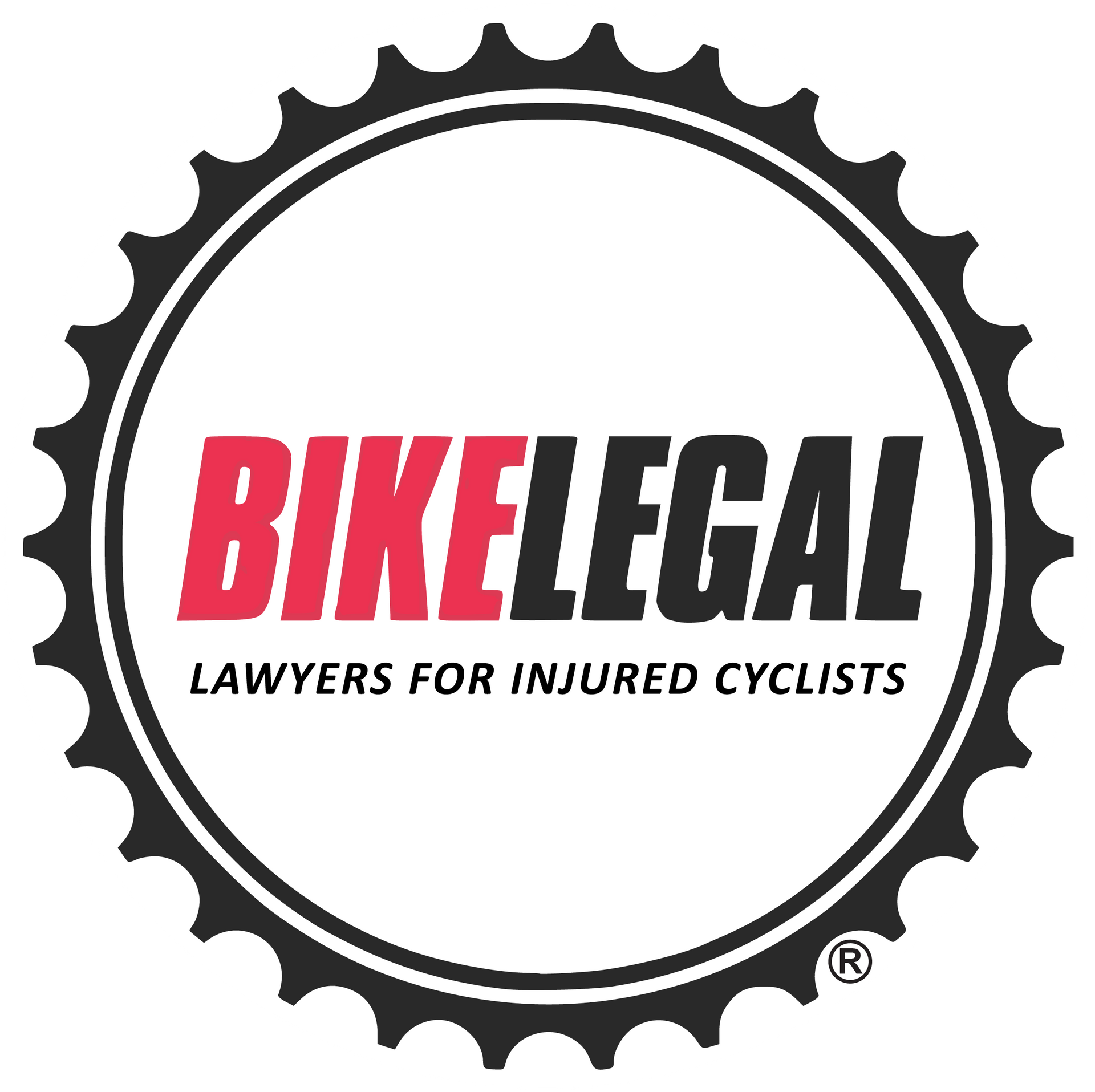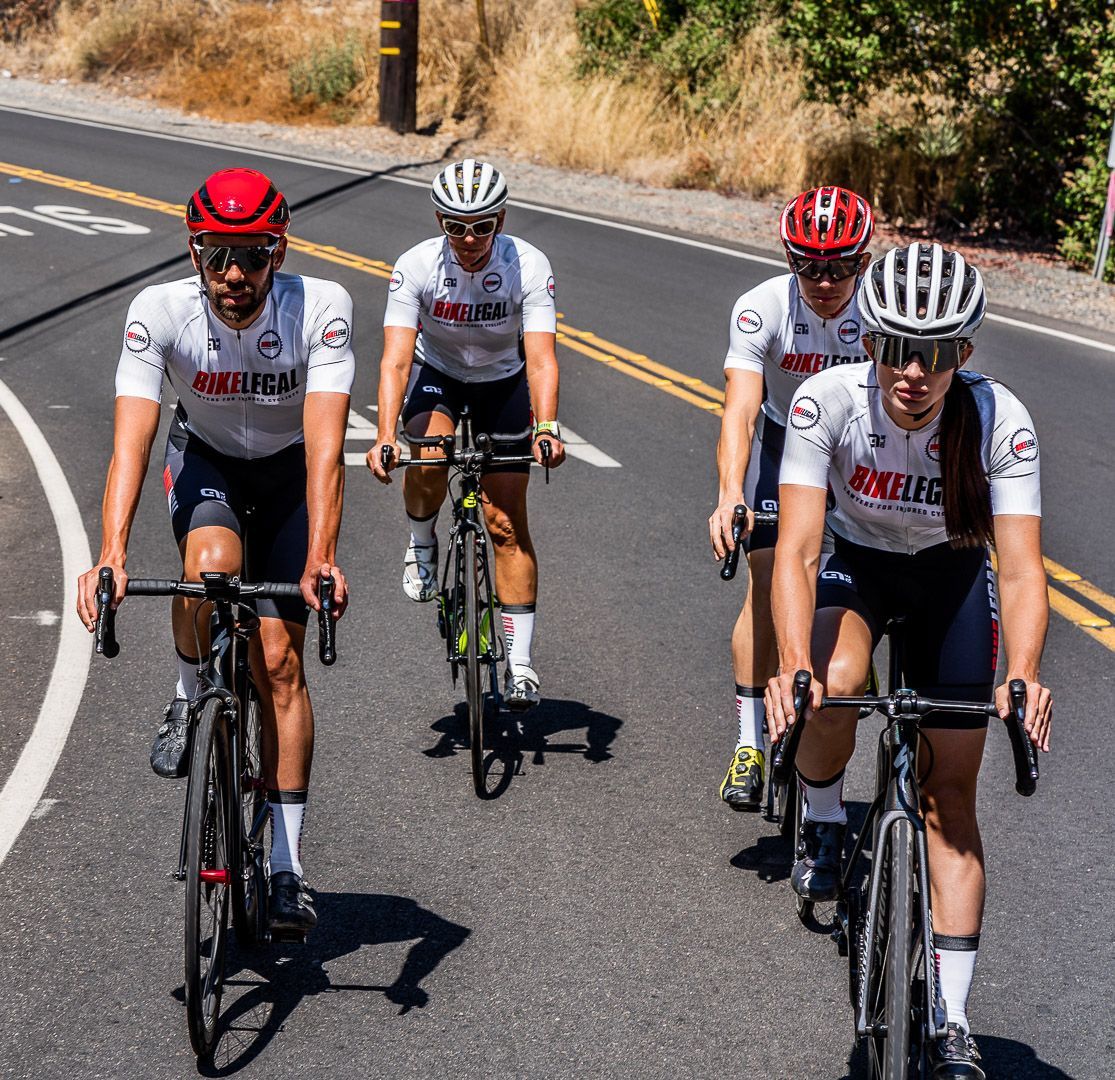Los Angeles Hit and Run Bicycle Crashes: A Deadly Epidemic
Follow us on
social media!
Los Angeles is ground zero for hit and run crashes in California, especially for cyclists. Both LA County and the City consistently report the highest number of bicycle injuries and fatalities in the state. In many of these cases, the driver flees the scene.
Let's be clear: Los Angeles hit and run bicycle crashes aren't accidents. They are crimes.
According to the 2024 Vision Zero Safety Study, nearly 1 in 3 serious or fatal bicycle collisions in LA involve a hit and run driver, a disturbing rise from just 22% in 2017. Meanwhile, the LAPD increasingly refuses to document crashes unless the cyclist is killed or catastrophically injured. That means the true scope of this epidemic is even worse than the official numbers suggest.
This guide explains why hit and run bicycle crashes are rising in LA, where they happen most, what you can do to protect yourself, and how a hit and run accident attorney can help you get justice.
Why Los Angeles Hit and Run Bicycle Accidents are So Common
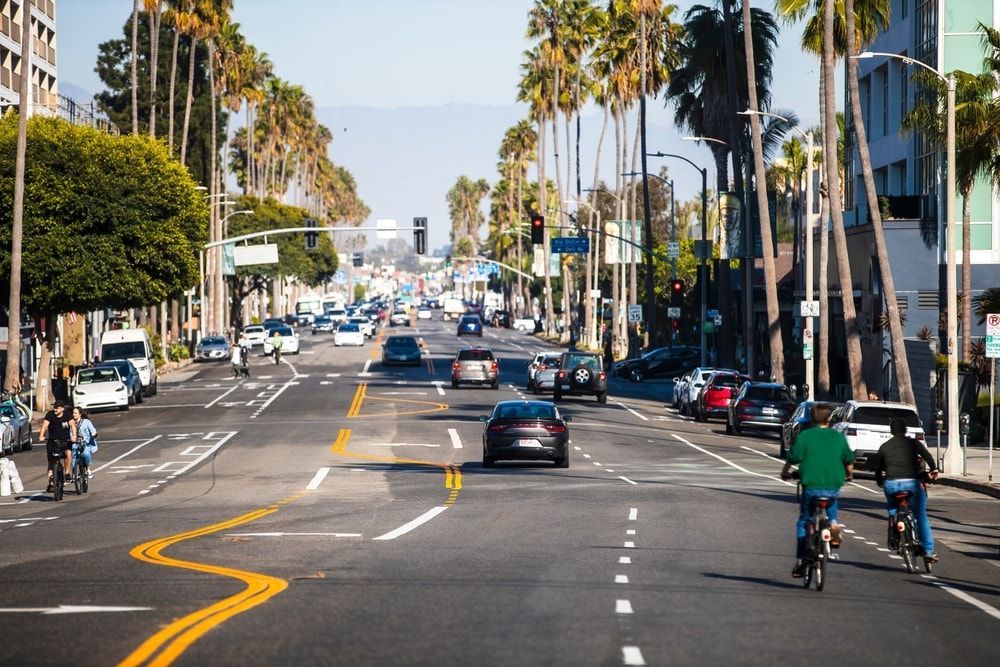
Los Angeles has the highest rate of bicycle hit and run crashes in California, and it's no coincidence. Several local factors make the city especially dangerous for cyclists and attractive to fleeing drivers.
Fragmented Bike Infrastructure
Los Angeles’ bike lane network is highly fragmented, forcing cyclists onto busy, high-speed roads with minimal protection. Bike lanes frequently end abruptly, pushing cyclists into general traffic lanes. Additionally, many bike lanes suffer from poor maintenance, including faded markings and debris, and inconsistent design standards vary widely across neighborhoods.
This fragmented infrastructure increases the risk of collisions and can cause drivers to panic or fail to realize they have hit a cyclist, contributing to the high rate of hit-and-run crashes.
Urban Sprawl and Easy Escape Routes
Covering over 4,000 square miles, Los Angeles’ sprawling urban landscape includes countless side streets, alleys, and freeway ramps, offering multiple escape routes for drivers fleeing crash scenes. Unlike more compact cities, LA’s size and complex road network allow drivers to blend into heavy traffic or quickly take alternate routes.
This, combined with inconsistent surveillance camera coverage and delayed police response times, reduces the likelihood of apprehension after a hit-and-run incident.
Lack of Police Enforcement and Reporting
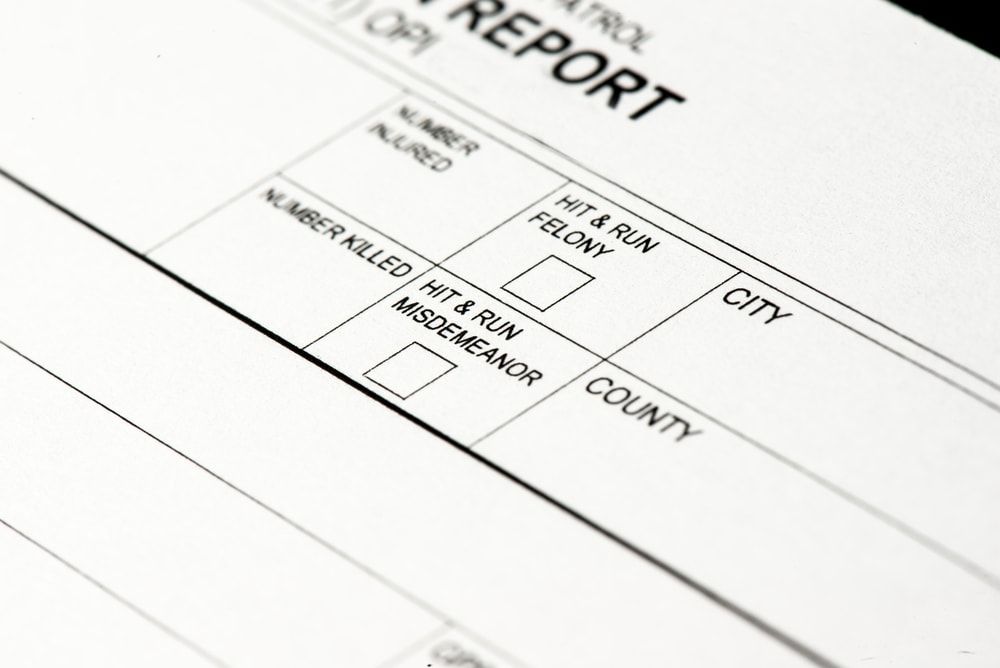
LAPD often doesn't respond unless a cyclist is seriously injured or killed. This lack of accountability emboldens reckless and uninsured drivers.
As detailed in our article on LAPD's new traffic collision report policy, the department has significantly scaled back its response to traffic collisions. This policy creates a situation where many drivers are aware that causing a "minor" crash with a cyclist, even if they're at fault, is likely to result in no police response or investigation. This knowledge reduces the perceived consequences of leaving the scene.
Nighttime Risk
More than half of LA's fatal bike crashes happen at night, often on poorly lit streets, increasing the likelihood of a collision and making it harder to identify fleeing drivers.
Los Angeles has numerous streets with:
- Long stretches between crosswalks or traffic signals
- High-speed traffic despite pedestrian and bicycle presence
- Limited visibility at intersections and crossings
These conditions create a perfect storm for nighttime hit-and-run crashes, where drivers may have reduced visibility, higher speeds, and greater confidence that they won't be identified if they flee.
Impaired and Unlicensed Drivers
Los Angeles has one of the nation’s highest rates of uninsured drivers. Many drivers are impaired, undocumented, or driving illegally, and they often flee crash scenes to avoid arrest.
For these individuals, fleeing is perceived as less risky than remaining at the scene, especially given the generally low clearance rates for hit-and-run cases.
Traffic Congestion and Road Rage
LA’s notorious traffic jams foster aggressive, distracted, and impulsive driving behaviors. Drivers frequently make sudden lane changes, speed when gaps appear, and become frustrated or reckless. When these drivers strike cyclists, they may flee the scene to avoid facing legal consequences. This combination of congested roads and aggressive driving further increases the risk of hit-and-run crashes.
Common Reasons Why Drivers Flee the Scene of a Bicycle Crash

Los Angeles hit and run drivers often leave the scene because they fear the consequences. Here are the most common reasons they run:
1. Impaired Driving
Fleeing the scene helps avoid DUI charges, which carry stiff penalties in California, especially when a cyclist is seriously injured. Under California Vehicle Code Section 23153, a DUI causing injury can result in:
- Felony charges with state prison time
- Substantial fines up to $5,000
- License suspension or revocation
- Mandatory alcohol or drug treatment programs
- A "strike" under California's Three Strikes law
When impaired drivers hit cyclists, the fear of these severe consequences often outweighs their moral obligation to stop and render aid.
2. Unlicensed or Uninsured Drivers
Approximately 16.6% of drivers in Los Angeles are uninsured. Many are unlicensed or undocumented and fear arrest, deportation, or vehicle impoundment.
For these drivers, staying at the scene could mean:
- Vehicle impoundment (with substantial fees to retrieve)
- Criminal charges for driving without a license
- Potential immigration consequences
- Personal financial liability for damages and injuries
- Loss of employment if transportation is unavailable
The combination of these fears creates a powerful incentive to flee.
3. Fear of Legal Consequences
The intense fear of legal consequences often drives drivers to flee the scene of a bicycle crash. They are deeply concerned about the following potential penalties:
- Imprisonment: A hit-and-run conviction can lead to up to 1 year in state prison or county jail.
- Fines: Drivers may face fines ranging from $1,000 to $10,000, or both.
- Serious Injury or Death: If the crash causes death or permanent, serious injury, the penalties escalate to 2 to 4 years in state prison, or 90 days to 1 year in county jail, along with fines.
- Additional Consequences: Fleeing after serious violations like gross vehicular manslaughter while intoxicated could add another 5 years to the prison sentence.
The overwhelming fear of facing these severe legal consequences often outweighs the moral obligation to stay and assist, leading drivers to make the split-second decision to flee.
4. Denial of Wrongdoing
Some drivers claim they "didn't see" or "didn't realize" they hit someone, especially on poorly lit streets. While this may sometimes be true, it's often a convenient excuse for leaving the scene.
Psychological factors that contribute to this behavior include:
- Shock and panic after realizing they've hit someone
- Cognitive dissonance ("I'm a good person, so I couldn't have done something terrible")
- Rationalization ("The cyclist must be fine if they're moving")
- Fear of confrontation with the injured cyclist or witnesses
These psychological mechanisms allow drivers to justify leaving the scene, even when they know they've caused a crash.
Los Angeles Hit and Run Bicycle Crash Statistics
- Between 2019 and 2022, bicyclists in unincorporated areas of Los Angeles County were involved in 815 traffic collisions, resulting in 12 fatalities and 121 severe injuries.
- In 2022, Los Angeles reported a total of 475 bicycle-related fatalities and injuries, including 24 cases involving children under the age of 15.
- According to the 2024 Vision Zero Safety Study, which analyzes data through 2023, approximately 27% of bicycle-involved KSI (Killed or Seriously Injured) collisions were hit-and-run. This represents an increase from 22% reported in the 2017 Safety Study.
- Between 2002 and 2012, more than 5,600 cyclists were injured, and at least 36 died in hit-and-run incidents. Los Angeles hit and run bicycle accidents have surged by 42%.
This alarming local trend reflects a national pattern of rising cyclist deaths and injuries. To understand how these numbers fit into the broader picture, refer to our detailed guide on 2022 Cyclist Death and Injuries Statistics in the US, which breaks down the data and highlights key factors driving this increase nationwide.
High-Risk Zones for Cyclists in Los Angeles
Reports from Jan. 1, 2022–Oct. 31, 2024 show the most notorious areas of Los Angeles for hit-and-run incidents (all road users):
- South Los Angeles: the LAPD's 77th Street division recorded 42 hit-and-run fatalities (all road users)
- Southeast LA: 29 hit-and-run deaths
- Southwest LA: 28 hit-and-run deaths
- High-risk neighborhoods: Vermont Square (14 deaths), Downtown (12), and Florence (12)
Contributing Factors to Bicycle Crashes
- Multi-lane roads: About 77% of cyclist fatalities happen on Los Angeles roads with three or more lanes per direction
- Lack of bike lanes: Around 85% of crashes occur on roads without dedicated bike lanes
- Poor lighting: 54% of fatal accidents happen at night, with visibility being a major factor
High-Risk Locations in LA County (2022 Report)
- East Anaheim Street, Long Beach
- Martin Luther King Jr Blvd & Figueroa Street, Los Angeles
- Figueroa Street, Downtown LA
- Avenues H & J, Lancaster
Los Angeles Bicycle Collision Report – May 2025 Update
As of May 2025, the Los Angeles Police Department (LAPD) reported a total of 234 bicycle-involved collisions year-to-date, representing a 23.2% increase compared to 190 collisions during the same period in 2024. However, severe injuries and fatalities (classified as K and A-level injuries) in bicycle crashes numbered 43, which is a 4.4% decrease from the previous year.
Understanding the KABCO Injury Scale
To properly interpret these statistics, it’s essential to understand the KABCO injury scale, the classification system law enforcement uses to categorize injury severity in traffic crashes:
- K (Killed): Fatalities occurring at the scene or within 30 days of the crash
- A (Suspected Serious Injury): Severe injuries preventing normal activities, such as broken bones, severe lacerations, major head trauma, or paralysis
- B (Suspected Minor Injury): Visible injuries like bruises, abrasions, or minor cuts
- C (Complaint of Injury): Injuries reported by the victim but not externally visible
- O (No Apparent Injury): No visible injuries or reported pain
Since the LAPD doesn’t necessarily show up, or even document injuries below the KABCO codes of A’s and K’s, then that means that the LAPD doesn’t document the majority of bicycle crashes in Los Angeles. Therefore, these numbers are far from realistic.
The chart below paints a different picture. This is the top 10 cities in California for Bicycle Fatalities and severe injuries according to UC Berkeley SafeTrek Injury Mapping System
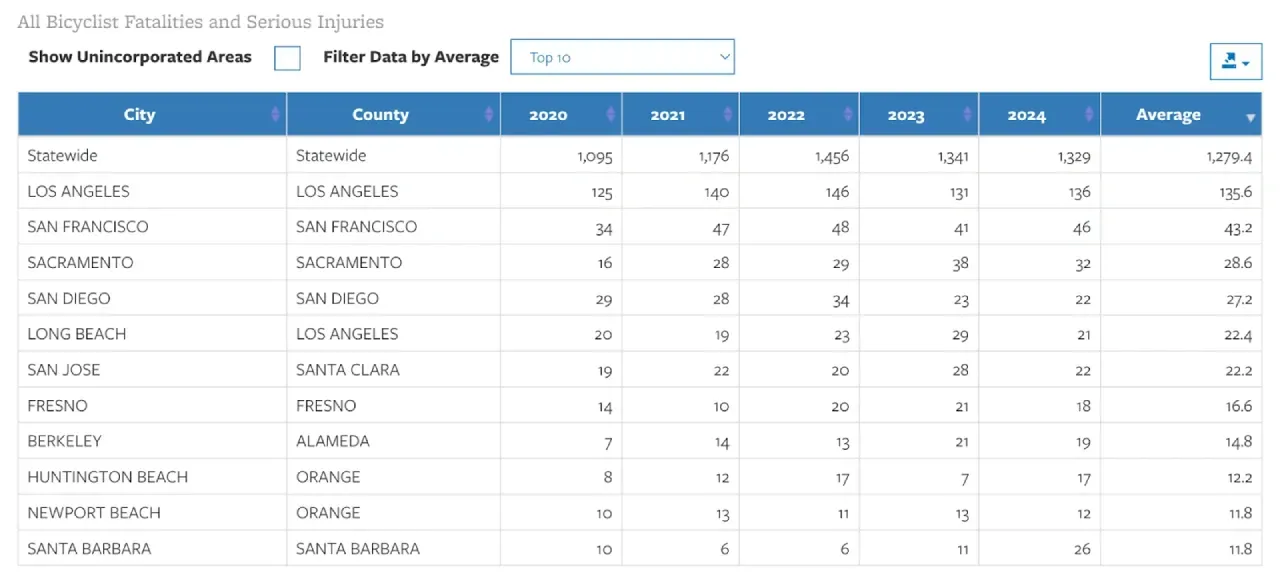
Top 10 California counties for bicycle fatalities:
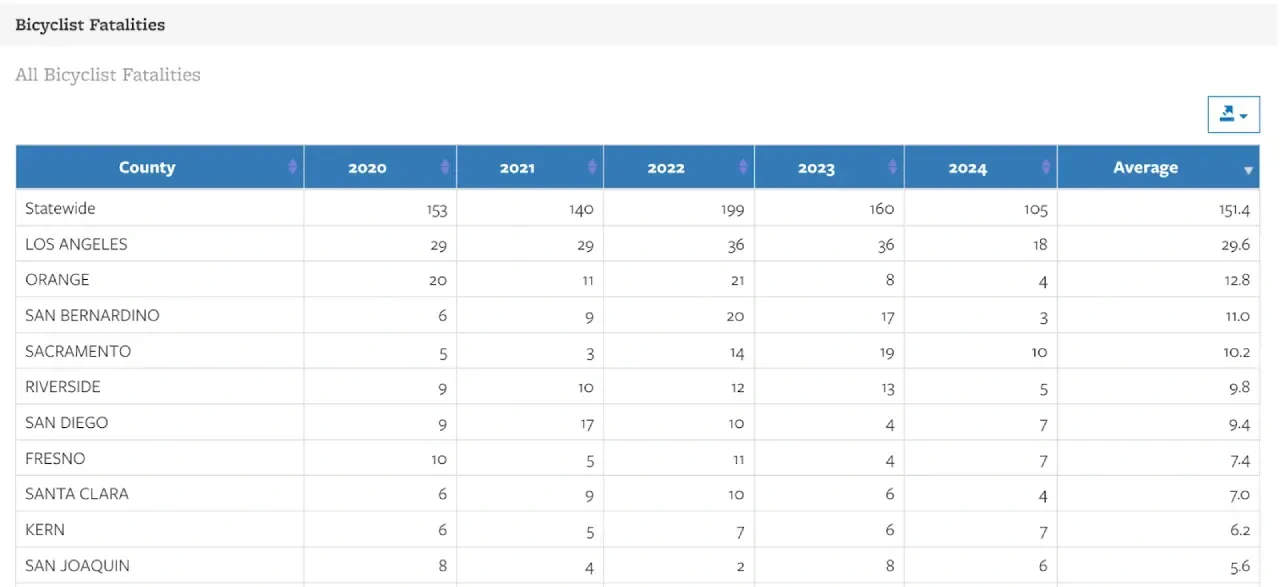
Los Angeles City Bicycle Fatalities due to Hit and Run accidents:

As explained in our article on LAPD's new traffic collision report policy, this practice severely underrepresents the true scale of the bicycle safety crisis in Los Angeles. Many cyclists with B and C-level injuries never appear in official data, creating a false impression of the actual danger cyclists face on LA streets.
Legal Requirements and Penalties for Hit and Run Drivers in California
California law is clear about a driver's responsibilities after a crash, with severe penalties for those who flee the scene, especially when injuries are involved.
Drivers Involved in Injury or Fatal Accidents (Section 20001)
Drivers involved in an accident causing injury to another person or death must immediately stop at the scene and fulfill the requirements of Sections 20003 and 20004. Failure to comply carries serious penalties, including imprisonment and fines.
Penalties include:
- Imprisonment in a state prison or county jail for up to 1 year.
- Fines ranging from $1,000 to $10,000, or both.
- If the accident causes death or permanent, serious injury (loss or permanent impairment of a bodily member or organ):
- Imprisonment in state prison for 2, 3, or 4 years, or county jail for 90 days to 1 year.
- Fines between $1,000 and $10,000, or both.
- Additional consecutive 5-year imprisonment if the driver flees the scene after certain Penal Code violations (Sections 191.5 or 192), provided this is charged and proven in court.
- Courts may reduce fines or imprisonment based on the defendant’s ability to pay or other considerations.
Drivers Involved in Property-Damage Accidents (Section 20002)
Drivers involved in accidents resulting only in property damage must immediately stop at the nearest safe location without blocking traffic or endangering others.
They must then either:
- Locate and notify the owner or person in charge of the damaged property, providing their name and address, and present driver’s license and vehicle registration upon request. If the vehicle owner is present, they must also present valid ID when asked.
- Or leave a written notice in a conspicuous place on the damaged property containing the names and addresses of the driver and owner, along with a statement of the accident circumstances. The driver must also notify the local police or California Highway Patrol promptly.
If a parked vehicle becomes a runaway vehicle, causing damage before being driven again, the responsible person must comply with these requirements.
Failure to comply with Section 20002 is a misdemeanor punishable by:
- Up to 6 months in county jail.
- A fine of up to $1,000.
- Or both jail time and fine.
City of Los Angeles Hit and Run Reward Program
The City of Los Angeles often offers standing rewards for information leading to the identification and apprehension of hit and run drivers who cause injuries. These rewards typically range from $5,000 to $50,000, depending on the severity of the crash and injuries.
The reward program aims to:
- Encourage witnesses to come forward with information
- Increase the chances of identifying and arresting hit-and-run drivers
- Send a message that the city takes these crimes seriously
- Provide some measure of justice for victims and their families
Despite these incentives, the clearance rate for hit-and-run cases remains low, with many drivers remaining unidentified or unaccountable.
What is the City of Los Angeles Doing to Improve Infrastructure for Pedestrians and Cyclists?
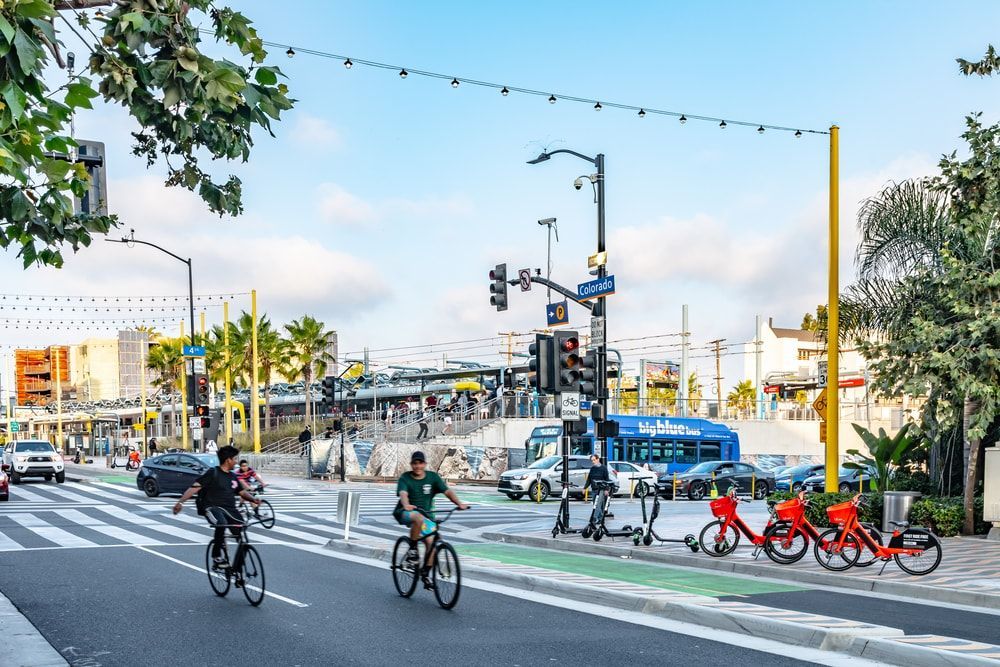
Measure HLA: The Promise
In March 2024, Los Angeles voters overwhelmingly approved Measure HLA (Healthy Streets LA), with nearly two-thirds (63%) voting in favor. This citizen-led initiative requires the city to implement the long-delayed street safety projects outlined in the Mobility Plan 2035 whenever streets are repaved.
Key components of Measure HLA include:
- Construction of over 400 miles of protected bike lanes and paths
- Implementation of bus lanes to improve transit efficiency
- Pedestrian safety improvements including enhanced crosswalks and sidewalks
- Traffic calming measures in high-injury corridors
The measure represented a clear mandate from voters for safer, more multimodal streets that serve all road users, not just drivers. Importantly, Measure HLA doesn't require new taxes or funding; it simply mandates that when the city repaves streets that are designated in the Mobility Plan, it must implement the safety improvements outlined in the plan.
Measure HLA: The Reality
More than a year after voters approved the measure, implementation has been frustratingly slow. Instead of immediately beginning work on safety improvements, the city has been mired in bureaucratic processes:
- It took nearly five months after the election (until July 30, 2024) for the City Council to adopt initial instructions to city departments on how to implement HLA
- The City Attorney took another four months to deliver a draft implementation ordinance (November 15, 2024)
- Committee hearings and amendments continued into February 2025
- As of early 2025, the ordinance was still awaiting final approval from the full City Council
Meanwhile, more than 260 people have been killed in traffic crashes since HLA passed, with thousands more injured. Los Angeles continues to have the highest pedestrian death rate among major U.S. cities.
Perhaps most concerning, city departments appear to be deliberately avoiding repaving streets that are designated in the Mobility Plan—a tactic that allows them to sidestep the HLA requirements altogether.
What to Do After a Los Angeles Hit and Run Bicycle Accident
If you're involved in a hit and run bicycle accident in Los Angeles, taking the right steps immediately afterward can significantly impact your physical recovery, legal rights, and ability to receive compensation.
Immediate Steps:
- Move to a safe location if possible.
- Call 911 to report the bike accident and request medical help.
- Take photos and videos of the scene, your injuries, and bike damage before anything is moved.
- Note road conditions, traffic signals, and weather.
Gather Evidence:
- Record vehicle details if you can: make, model, color, license plate (even partial), direction of flight, and any unique features.
- Collect contact info from witnesses and request for surveillance video.
- Look for nearby surveillance cameras (traffic, businesses, homes).
Medical and Legal Actions:
- Seek medical treatment promptly, even for minor injuries, and keep all medical records. For detailed advice, visit our guide on Bicycle Injury Treatment.
- File a police report as soon as possible and request a copy for your records.
- Track all accident-related expenses, missed work, and maintain a recovery journal.
- Don’t speak to insurance adjusters – Their primary goal is to minimize or deny your claim. Instead, contact a Los Angeles hit and run lawyer before providing detailed statements.
For detailed guidance, read our guide on What to Do After a Bicycle Accident.
The Most Important Coverage You Probably Don’t Have: Why UM/UIM Insurance Is Critical Protection
Uninsured/Underinsured Motorist (UM/UIM) coverage is one of the most essential protections you can have, especially if you ride a bicycle. In Los Angeles and other high-risk areas, where hit-and-run crashes and uninsured drivers are alarmingly common, UM/UIM may be the only way to recover compensation after a crash.
Why Every Motorist and Cyclist Needs UM/UIM Coverage
UM/UIM is an optional addition to California auto policies, and it’s our #1 recommended safety protection for anyone who rides a bike or drives a vehicle. It provides coverage when the at-fault driver either has no insurance or doesn’t have enough to cover your injuries and losses.
For cyclists, this is critical. We face a greater risk of serious injury in a crash. Yet, most drivers carry only the California state minimum liability limits, which often fall far short of what is needed for hospital bills, rehabilitation, lost wages, or long-term care.
You Don’t Need to Own a Car to Be Covered
Many cyclists believe that UM/UIM coverage is only available to car owners, but that’s not true. You can purchase a non-owner insurance policy that includes UM/UIM coverage, giving you financial protection even if you don’t have a vehicle.
Affordable, High-Impact Protection
UM/UIM coverage is relatively inexpensive, especially considering its value after a crash. We recommend getting as much as you can reasonably afford. This protection follows you whether you’re biking, driving, walking, or riding as a passenger.
Don’t wait until after a crash to realize you’re unprotected. Whether you drive daily or don’t even own a car, UM/UIM coverage could be your financial lifeline after a serious bicycle accident.
Policy Limits and Supplemental Coverage
California does not require UM/UIM coverage. It's an optional additional rider to your policy.
Los Angeles cyclists should consider higher UM/UIM limits (ideally $250,000 or more) given the city's high medical costs and the severity of typical bicycle accident injuries.
Contact your auto insurance provider TODAY and inquire about adding the maximum amount of UIM/UM insurance to your policy. For surprisingly little added cost, it protects you if you're the victim of a hit-and-run accident.
Why You Need a Los Angeles Bicycle Accident Attorney After a Hit and Run Crash
Consult with a Los Angeles bicycle accident attorney as soon as possible after a hit and run accident. Early legal intervention can be crucial for preserving evidence, identifying potential witnesses, and ensuring your rights are protected throughout the claims process. A hit and run accident lawyer specializing in bicycle accident claims will understand the unique challenges and will explore every avenue available for compensation.
How a Hit and Run Accident Lawyer Can Help Your Case
A bicycle accident lawyer brings specialized knowledge of cycling laws, traffic regulations, and insurance practices that general practice attorneys may lack.
- Scene investigation specific to Bicycle crashes
- Navigate complex insurance claims processes
- Negotiate with insurance companies to maximize your compensation
- Experts in bicycle property damage claims
- Represent you in court if a fair settlement cannot be reached
Statute of Limitations and Critical Deadlines
In California, you generally have two years from the date of the accident to file a personal injury lawsuit. However, if your claim involves a government entity (such as poor road maintenance contributing to the accident), you may have as little as six months to file an administrative claim.
To understand the process of the hit and run accident claims, read our guide on Hit-and-Run Bicycle Accidents & How to Pursue Legal Action.
Prevention and Safety Tips
While you can't control other drivers' actions, you can take steps to reduce your risk of being involved in a hit-and-run crash and improve your chances of identification and recovery if one occurs.
Increasing Visibility
- Use proper lighting: Front white light and rear red light, especially at night. Read our Bicycle Light Lumens Guide for recommendations on how bright your lights should be.
- Wear reflective clothing: Reflective vests, ankle bands, and helmet stickers significantly increase your visibility, especially in low-light conditions.
- Choose safe bicycle routes: Seek out well-lit streets with bike lanes whenever possible, and avoid areas with poor visibility or high-speed traffic.
Visibility is your first line of defense against crashes. Many drivers claim they "didn't see" the cyclist they hit. Don't give them that excuse.
Defensive Cycling Techniques
- Ride predictably: Follow traffic laws and signal your intentions using proper bike hand signals.
- Maintain awareness: Limit distractions and be vigilant of the cars around you. Avoid using headphones while riding your bike.
- Take the lane when necessary: If a roadway does not have a bike lane, and is too narrow to share the lane safely with a vehicle, ride in the center of the lane until it is safe to return to the far right side again.
Our friend Phil Gaimon has a fantastic video highlighting cyclists’ right to take the lane for safety.
Safety Equipment
- Always wear a helmet: It reduces the risk of head injury by up to 85%. Our guide on bike accidents without helmets explains the risks and legal implications of riding without a helmet.
- Consider cameras: Bike-mounted cameras can document incidents and provide evidence if you're involved in a crash.
- Use tracking devices: GPS trackers on your bike can help recover stolen property and potentially identify your location if you're injured in a remote area.
For more recommendations on safety gear, check out our article on the 16 best bicycle safety accessories for safer rides.
Conclusion
Los Angeles remains one of the most dangerous places in California to ride a bicycle, especially when it comes to hit-and-run crashes. A combination of inadequate infrastructure, high rates of uninsured drivers, and limited police response leaves cyclists vulnerable and often without justice.
While improving safety on our streets will require systemic change, there are steps every cyclist can take right now. Knowing your rights, documenting incidents, and understanding how hit-and-run cases work are all essential.
One of the most important forms of protection you can have is Uninsured/Underinsured Motorist (UM/UIM) coverage. In many hit and run accidents, it may be the only path to financial recovery. Whether you drive daily or don’t own a car at all, this type of insurance offers critical protection for anyone who uses the road.
As long as hit and run accidents continue to rise, cyclists must be prepared, not just physically, but legally and financially. Stay informed. Stay protected. And advocate for safer streets for everyone.
Injured in a Los Angeles Hit and Run Bicycle Crash? Bike Legal is on Your Side.
At Bike Legal, we ride the same streets you do, and we know the risks. We’ve helped countless cyclists recover compensation after devastating hit and run crashes, even when the driver was never found.
Whether it’s filing a UM claim, preserving critical evidence, or forcing an insurance company to do the right thing, we fight for cyclists with skill and passion.
📞 Call 877-BIKE LEGAL (877-245-3534) for a free consultation. We’ll help you get answers—and justice.
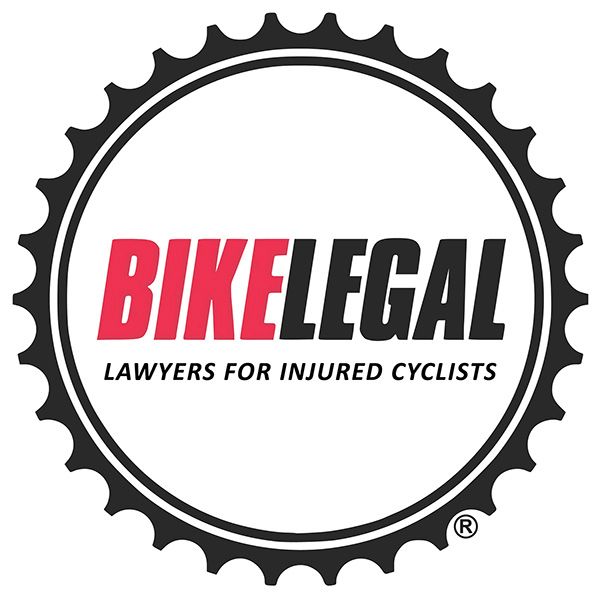
Frequently Asked Questions
Can I still receive compensation if the hit and run driver is never found?
Yes, you may still be eligible for compensation through your own uninsured motorist coverage, health insurance, or other sources. A hit and run accident lawyer can help identify all potential avenues for recovery.
Do I need a lawyer after a bicycle hit and run?
Hiring a specialized bicycle accident lawyer is strongly recommended due to the complexities of hit and run accidents. They can help navigate insurance challenges, investigate the crash, and often secure higher settlements than individuals can on their own.
What is Measure HLA doing for bike safety in LA?
Measure HLA mandates the installation of protected bike lanes, intersection improvements, and traffic calming on repaved streets. However, a year later, there hasn’t been much progress. LAPD reported 260 deaths since HLA was passed and thousands of injuries.
What insurance covers a cyclist hit by a car?
Coverage may include the at-fault driver’s liability insurance, your own UM/UIM coverage, medical and health insurance. Some homeowner or renter policies may also cover damage to bikes or personal items.
What if I don't own a car—can I still get UM coverage?
Yes, non-owner auto insurance policies offer UM/UIM protection for people without vehicles. These affordable policies cover you when cycling, walking, or as a passenger, providing essential financial protection against uninsured or hit-and-run drivers.
